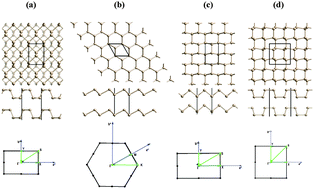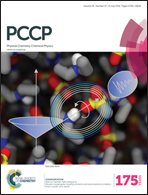Electronic structure engineering of various structural phases of phosphorene†
Abstract
We report the tailoring of the electronic structures of various structural phases of phosphorene (α-P, β-P, γ-P and δ-P) based homo- and hetero-bilayers through in-plane mechanical strains, vertical pressure and transverse electric field by employing density functional theory. In-plane biaxial strains have considerably modified the electronic bandgap of both homo- and hetero-bilayers while vertical pressure induces metallization in the considered structures. The γ-P homo-bilayer structure showed the highest ultimate tensile strength (UTS ∼ 6.21 GPa) upon in-plane stretching. Upon application of a transverse electric field, the variation in the bandgap of hetero-bilayers was found to be strongly dependent on the polarity of the applied field which is attributed to the counterbalance between the external electric field and the internal field induced by different structural phases and heterogeneity in the arrangements of atoms of each surface of the hetero-bilayer system. Our results demonstrate that the electronic structures of the considered hetero- and homo-bilayers of phosphorene could be modified by biaxial strain, pressure and electric field to achieve the desired properties for future nano-electronic devices.


 Please wait while we load your content...
Please wait while we load your content...